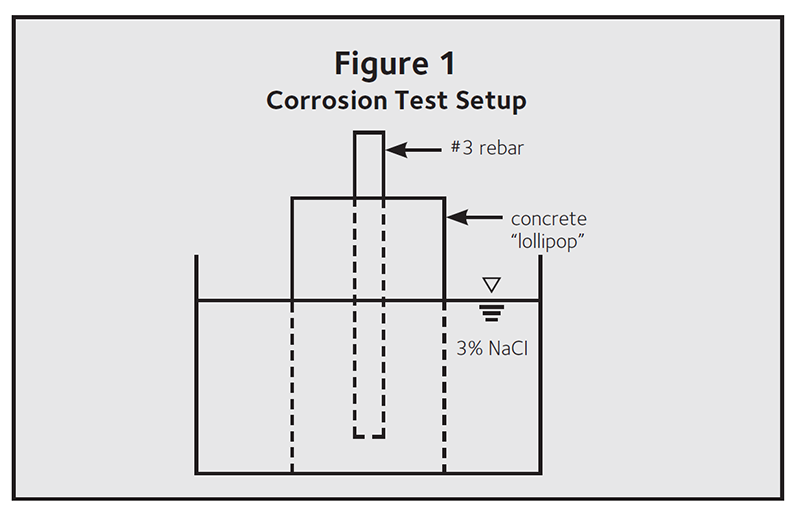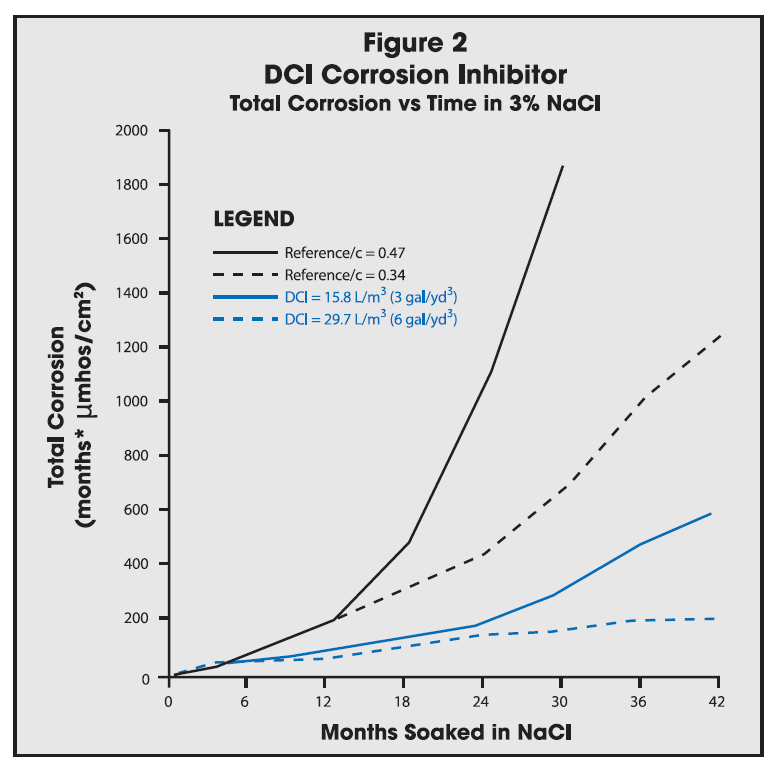A Laboratory Study
In 1984 the latest large scale accelerated corrosion test program was initiated examining the effects of concrete mix design and DCI® corrosion inhibitor on the corrosion resistance of steel. An accumulation of all corrosion measurements or total corrosion of the steel is presented here in order to show how rebar corrosion affects concrete deterioration. This study used 75 mm (3 in.) diameter by 150 mm (6 in.) high “lollipops” partially submerged in a 3% sodium chloride solution. The “lollipop” (Figure 1) consisted of a No. 3 [9.5 mm diameter (3/8 in.)] rebar embedded in concrete cylinders. Concrete cover over the rebar remained constant at 33 mm (1.3 in.) with the variables being water/cement ratio and the amount of DCI®.
Corrosion rates were measured every three months for the first two years and then at 6 month intervals using polarization resistance techniques (correcting for concrete resistance). By adding these measurements (integrating over time), total corrosion is determined as shown in Figure 2.
A total corrosion measurement of 1000 µmho-month/cm2 is roughly equivalent to 1 mil average depth of corrosion on the steel. This is considered enough to cause rust staining or cracking of the concrete at localized sites. Chloride levels were also measured at different “lollipop” vertical elevations throughout the test program.
Conclusions
- DCI® significantly improves the corrosion resistance of steel in concrete, especially below water/cement ratios of 0.50.
Figure 1
Figure 2
- DCI® - protected concrete, at a water/cement ratio of 0.45, has lower total corrosion than unprotected concrete with a water/cement ratio of 0.34.
- Chloride levels are significantly reduced by lowering the concrete water/cement ratio.
- When corrosion begins at high chloride levels in DCI® concrete, the corrosion rate is lower than corrosion rates in unprotected concrete.
- DCI® protects at chloride to nitrite ratios exceeding 1.5:1.0 by weight, based on original nitrite content.
- Visual analysis of autopsied rebars confirmed that when the polarization resistance technique indicated corrosion, there was indeed corrosion product on the steel. High corrosion rate measurements correlated with more rust product.
This Technical Bulletin 0907 is based on “The Effects of Calcium Nitrite and Mix Design on the Corrosion Resistance of Steel in Concrete Results”, by Dr. N. S. Berke, which was published in NACE’s Corrosion — March 1987, and continuation of these experiments.
gcpat.com | North America Customer Service: +1 (877) 423 6491
We hope the information here will be helpful. It is based on data and knowledge considered to be true and accurate and is offered for consideration, investigation and verification by the user, but we do not warrant the results to be obtained. Please read all statements, recommendations and suggestions in conjunction with our conditions of sale, which apply to all goods supplied by us. No statement, recommendation, or suggestion is intended for any use that would infringe any patent, copyright, or other third party right.
GCP, GCP Applied Technologies and DCI® are trademarks, which may be registered in the United States and/or other countries, of GCP Applied Technologies Inc. This trademark list has been compiled using available published information as of the publication date and may not accurately reflect current trademark ownership or status.
© Copyright 2019 GCP Applied Technologies Inc. All rights reserved.
.
In Canada, 294 Clements Road, West, Ajax, Ontario, Canada L1S 3C6.
GCP0083 TB-0907-0418
GCP Applied Technologies Inc., 2325 Lakeview Parkway, Suite 475, Alpharetta, GA 30009, USA
GCP Canada, Inc., 294 Clements Road, West, Ajax, Ontario, Canada L1S 3C6
This document is only current as of the last updated date stated below and is valid only for use in the United States. It is important that you always refer to the currently available information at the URL below to provide the most current product information at the time of use. Additional literature such as Contractor Manuals, Technical Bulletins, Detail Drawings and detailing recommendations and other relevant documents are also available on www.gcpat.com. Information found on other websites must not be relied upon, as they may not be up-to-date or applicable to the conditions in your location and we do not accept any responsibility for their content. If there are any conflicts or if you need more information, please contact GCP Customer Service.
Last Updated: 2024-06-21
https://gcpat.com/en/solutions/products/dci-corrosion-inhibitor/tb-0907-effects-dci-corrosion-rates-steel-concrete

